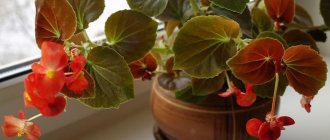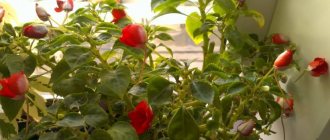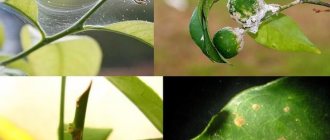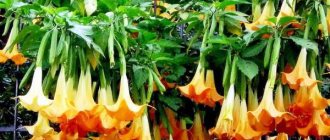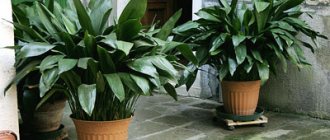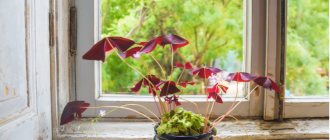Impatiens is a very popular flower due to its beauty and unpretentiousness.
Impatiens is one of the oldest inhabitants of gardens and apartments, which does not lose its popularity even today. It is enough to go to any forum of flower growers and gardeners, where you can always find many photos and discussions, the hero of which is Vanka wet. This is the second common name of the flower in our country, due to the fact that after watering small droplets form on the leaves. But the British call it “zealous Lisa” for its long flowering.
Description
Impatiens is one of the most popular indoor plants. It is valued for its unpretentiousness, long flowering and decorative appearance.
Balsam has many popular names:
- “Vanka - wet” flower is called because when there is high humidity, droplets of water appear on its leaves.
- “Touch-me-not” for its extremely delicate seed pods that fly apart when touched.
- “Ogonyok” and “Eternal Flower” are the names given to the plant for its long and bright flowering.
All varieties are quite easily propagated by seeds and cuttings, so even a novice gardener can cope with collecting material and planting.
Depending on the variety and type, the height of the plants can be from 17 to 58 cm. Balsam shoots are juicy and strong. The leaf blades are dense and fleshy. The leaves are round or slightly elongated oval in shape. The edges of the leaf blades are wavy, the color can be green, green-red or bronze.
At home, balsam blooms profusely and for a long time. The flowers are small and located in the leaf axils.
The size of the flowers is small, but their number and brightness completely compensate for this drawback. Thanks to selection, you can find both simple and double flowers. The colors of balsam flowers are very diverse; the petals can be colored red, white, orange and purple. Hybrid varieties have striped, spotted or two-color petals.
Lush flowering is only possible in a cramped pot. If balsam is planted in a deep and spacious flowerpot, it will grow root and green mass for a very long time.
After the flowers fade, greenish fruit-boxes are formed in their place, inside of which there are seeds. If you touch the ripe fruits, the box bursts and the seeds shoot out in different directions. This mechanism in the natural environment helps plants sow their seeds in as much free space as possible.
The history of the wild weed
Due to the wide distribution and diversity of plants, it is impossible to accurately indicate the birthplace of wild balsam . It can be found in almost all parts of the world, temperate and tropical regions. But the main points of concentration are still considered to be the countries of Africa, Asia, Europe and North America.
The first information about this plant was obtained in 1689 in India and nearby regions of Asia. After which other flower growers began to become interested in the flower. One of them was Carl Linnaeus, to whom many of his associates owe the most complete description and systematization of many species.
The plant was gaining popularity among gardeners and was loved by many residents of the countries. Today, the flower in Russia is often called Vanka Mokrym , this is due to the fact that when air humidity increases (rain, fog), small droplets of sweet liquid form on the leaves, which after a while turn into sugar. In the West, the plant was called Busy Lizzie.
Popular types of balsam
More than 500 different types and subspecies of balsams are known. But only certain types of plants are suitable for growing at home. The most popular are Hawker's, Waller's and Niamey's balsams.
Hawker's Impatiens (Impatiens Hawkeri)
This species became the progenitor of many hybrid varieties. The most famous is the New Guinea hybrid Impatiens New Guinea, which has become popular due to its large flowers with a characteristic spur and year-round flowering. The leaf blades are slightly elongated, oval in shape, green or bronze in color. Sometimes there are plants with variegated leaf blades. The plant adapts perfectly to home conditions and develops well both in partial shade and on the sunny side.
Impatiens parviflora
A fairly large representative of the balsam family, which grows up to 53–68 cm in height. The shoots are erect, branched, succulent. The leaves are ovate-shaped with short petioles. The edge of the leaf blade is pointed and serrated. The flowers are small, pale yellow.
Waller's or Waller's balsam (Impatiens walleriana)
The species differs from others in its abundant flowering. There are so many flowers that they often cover all the leaves. The plant grows up to 15–55 cm. Waller's stems are dense, erect and succulent. The leaf blades are of an unusual brown-red color, wavy along the edges. The flowers come in both single-color and two-color.
Creeping balsam (Impatiens repens)
Quite a popular variety of creeping indoor plant. The shoots are reddish in color, succulent, and creeping. The leaf blades are small, heart-shaped. The flowers are solitary, small, up to 3 cm in diameter, deep yellow in color.
Niamey or parrot balsam (Impatiens niamniamensis)
The bushes of this species are lush, the foliage is abundant, pale green in color. The height of an adult plant is from 20 to 35 cm. The species has original flowers, which in shape strongly resemble a chili peach or bean. The petals of the buds are bright red, but there are rare specimens of balsams in which the flowers are colored in half green and red.
Reproduction methods
To propagate balsams, gardeners use two methods: cuttings or sowing seeds. Both methods are quite simple and suitable for all types of balsams.
Cuttings
For planting, select well-developed apical shoots from a strong mother bush. The cutting length is from 7 to 12 cm. The seedlings are rooted in a moist mixture of turf soil and sand. Instead of sand, you can use vermiculite, the main thing is that the soil is light and crumbly.
The lower leaves of the cuttings are torn off and buried 3–4 cm deep. The roots appear in about a week. To speed up growth, cover the root cup with the seedling with a bag or another cup. Greenhouses with cuttings are ventilated daily.
Seedlings can be rooted in water with growth stimulants, and after the roots appear, transplanted into a light soil mixture. After the cuttings grow roots, they are planted in mature soil in separate small-diameter pots.
Seeds
Seeds can be purchased at the store or collected independently from home plants. Usually the seeds are sown in late February or early March. For sowing, home greenhouses or mini-greenhouses are used.
Planting stages:
- Balsam seeds are sown in pre-prepared light soil from a mixture of peat and coarse sand.
- The seeds are scattered over the surface of the ground and sprinkled with a little soil.
- The germination temperature should be in the range from +22 to +25 °C.
- The plantings are covered with glass or a bag. Some gardeners germinate seed material in mini-greenhouses or aquariums.
- The plantings are ventilated daily and moistened as needed from a spray bottle.
- After the first shoots appear, watering is reduced, and the frequency and time of ventilation is increased.
- Young plants are planted in separate cups or cassettes 1-1.5 weeks after germination.
In order to collect balsam seeds, you need to tie the box with a piece of gauze or glue it with a strip of tape. This will help keep the box intact and the seeds will not scatter in an unknown direction.
Guseva Ulyana
Ask a Question
Question to the expert
How long do collected seeds remain viable?
Properly collected seeds can remain viable for about 5 years.
Sowing seeds
Preparing pots for planting seeds
Containers for seedlings are prepared in advance. These can be boxes, containers or pots slightly more than 7 cm high. Drainage holes are a prerequisite. A layer of expanded clay (1/5 of the height of the pot) is placed on the bottom of the prepared container, and the prepared soil is poured on top. It is advisable to spill the soil with a solution of “Fitosporin”, which enhances the protective properties of plants, prevents various diseases and improves the soil microflora.
Planting balsam seeds
Next, proceed to planting:
- The prepared soil in the container is watered with water.
- Seeds are distributed over the surface of the soil. This can be done with a thin stick or a regular toothpick. Wet the tip of the toothpick with water, pick up the seed and press it to the ground, slightly deepening it.
- Spray the surface of the soil with seeds from a spray bottle.
- Cover the container with a transparent lid or simply pack it in a plastic bag.
- The container with the seeds is placed on the windowsill. It is better to choose those windows where direct rays of the sun do not fall. The room temperature should be between 22–25 °C.
- Seedlings must be ventilated. To do this, remove the covers or cellophane, wipe off the condensation from them and let the soil breathe a little.
The first shoots appear after 18–20 days.
Planting balsam at home
Planting and growing balsam at home is very simple. First of all, it is necessary to prepare seedlings from seedlings or cuttings. Determine a place for a new resident and carefully read the rules of planting and growing.
Soil composition
Recommended by topic
Night Violet Stromanta Aloe
Store-bought mixtures for flowering plants are perfect for balsams. It is best to use light and poor soil compositions. With an abundance of minerals and nitrogen, balsam will grow foliage, and you may not even wait for flowering.
Composition of soil mixture 1:1:
- leaf soil;
- rotted compost;
- coarse sand or vermiculite;
- peat.
At the bottom of the pot, be sure to lay drainage made of pebbles, broken bricks or expanded clay.
Choosing a pot
The growth and flowering of balsam depends on the right pot. You should not plant the plant in a large-diameter flowerpot, since all the flower’s energy will be spent on growing roots and crowns. With this approach, you will have to wait a very long time for flowering, and the balsam may weaken and die.
The pot should have a deep tray to collect excess moisture. Some gardeners simply pour water into a tray, and the balsam absorbs as much as it needs. The remaining water is drained so that there is no stagnation of liquid.
The size of the pot should exceed the volume of the roots by only 3–6 cm. The root will quickly fill the entire free volume and the balsam will begin to grow.
Landing
Before planting, the flower is moistened generously and allowed to stand for a couple of hours. At this time, prepare the soil and pot.
Planting stages:
- Place a drainage layer on the bottom of the pot. And a thin layer of ready-made soil.
- Carefully remove the balsam from the old pot or cassette.
- Without breaking the earthen coma, transfer the seedling to a new pot and sprinkle it with earth.
- The earth is not compacted, but lightly crushed.
After planting, the plant is shaded or placed deeper into the room for weeks.
In order to get an unusual bouquet, two young seedlings with different, contrasting colors are planted in one pot. For example, white and orange. It is desirable that they be the same size and type.
Transfer
Flower growers recommend replanting young impatiens once a year. It is best to replant the plant in spring or autumn. Since balsams have no seasonal flowering, they are replanted regardless of whether there are flowers on the bushes or not. For transplantation, use the same scheme as when planting plants.
Impatiens must be transplanted to a new place after purchase, treatment and for rejuvenation.
Growing seedlings
Balsam shoots
For growing balsam from seeds, the optimal temperature is 23–25 °C. The containers are placed on a bright windowsill, but not in direct sunlight. After the first shoots appear, the bags and lids are removed from the containers, and the soil is moistened with a spray bottle. As the seedlings grow, you can carefully add soil, covering the young bare roots. Watering young plants should be uniform and sufficient, but do not over-water or dry out the soil.
Transplanted balsam sprouts
The first true leaves have appeared, which means it’s time to pick. Seedlings are planted in separate containers, for example, plastic cups. If the sprouts have stretched out a little, when replanting, they are buried a little more. Sufficient watering and lighting are important conditions for the correct and even development of small impatiens. They become strong and begin to grow side stems. If there is no branching, the tops of the bushes are pinched. This gives impetus to the active formation of side shoots. Their number directly affects the splendor of the future bush and the abundance of flowering.
Transplanting balsams into pots
The young seedlings grew up, and their roots entwined the earthen ball, filling the entire small container. The time has come to transplant the plant to a permanent place of residence in pots or flowerpots. Impatiens require a compact container so that after filling the space of the pot with roots, the flower will produce buds. When planted in pots that are too large, all the strength of the plant will go into growing greenery. It may not even come to flowers.
Rules for caring for balsam
When grown at home, balsam is unpretentious, so the plant is suitable for both professional gardeners and amateurs. But you still need to follow some rules, since if care standards are grossly violated, the balsam may lose its leaves or wither. The main parameters that need to be monitored are humidity and partial shade.
Watering mode
There is an opinion that it is better to overwater the balsam than to overdry it. And this is true, since an overdried flower quickly fades and sheds its foliage. But don’t go to extremes and fill the pot up to the neck. Excess moisture is just as harmful to balsam as it is to other plants. If water stagnates, the roots of the plant will rot, and a dangerous fungal disease can settle on the bushes.
Recommended by topic
Selaginella Spraying flowers: HOW? FOR WHAT? HOW? Light-loving plants for home and garden
It is worth paying attention to the general condition of the flower. In a plant that lacks moisture, the stems lose their elasticity and the lower leaves begin to fly off. In this case, it is necessary to revive the balsam with abundant watering.
In summer, water the flower every other day and make sure that the earthen ball always remains moist. In winter, watering is reduced to two or three times a week. But if the flower is located near heating devices, then the frequency of watering is adjusted depending on its condition.
Watering is best done in the evening. The water should be at room temperature without chlorine impurities. Well or filtered water is best.
Air humidity also matters. In normal times, air humidity, which is maintained in any apartment, is sufficient for balsam. But in extreme heat or during the heating season, the air becomes dry, so it is advisable to spray the flower in the evening.
Question to the expert
How to understand that a plant needs watering?
Unlike other indoor crops, balsam is more demanding of soil moisture. You should not wait for the top layer of soil to dry out, as this indicator is not suitable for moisture-loving plants. You should water the balsam on a schedule so that the soil remains slightly moist during the next watering.
Lighting
Most types and varieties of balsam tolerate direct sunlight, shade and partial shade. But it’s still worth considering that in the scorching summer sun the plant can get burned, and in dense shade the balsam will not bloom.
The ideal place for the flower would be south-west and south-east windows. There is enough light for the plant to bloom continuously and abundantly. You can also put balsam on a south window, but in the summer heat it needs to be shaded.
Many gardeners take balsams outside, onto the veranda, loggia or balcony in the summer. But they are placed so that the midday rays do not fall on the plant.
Temperature
Balsam is not picky about temperature parameters. In the summer, he will be quite happy with a room temperature of +18 +25 °C. In winter, to maintain flowering, the temperature should not fall below +12 °C.
Transfer
Over time, mature balsams grown in pots will require larger containers due to their rapid growth and significant root development. In areas with mild climates, flowers are usually replanted in the spring into a container slightly larger than the previous one. This will help prevent excessive development of the root system at the expense of the aboveground part. The plant should be replanted together with a ball of earth, and new fresh soil with a high content of organic matter should be added.
Diseases and pests
Impatiens are quite often exposed to various ailments and pest attacks. At the first signs of damage, it is necessary to immediately begin treatment. Since even a seemingly insignificant disease can lead to the death of a crop. Therefore, it is necessary to regularly inspect the plant for damage and symptoms of disease.
In some cases, a plant saved from disease and pests forever loses its decorative appearance. Flower growers recommend cutting healthy cuttings from such a bush and growing a new balsam.
| Diseases and pests | Cause, symptoms and signs of the disease | Treatment and prevention |
| Bronzing of leaves | Reason: virus. Characteristic signs: the growth of leaves and shoots slows down, leaf plates are deformed and covered with spots. | There is no quality treatment. Balsam affected by the disease is burned so that the disease does not spread to healthy plants. |
| Powdery mildew | Cause: a fungus that develops at low temperatures and excess humidity. Characteristic signs: the foliage droops, a white coating forms on the leaf blades and stem. | Treatment consists of adjusting the standards for caring for and treating the plant with Topaz and Forecast fungicides. |
| Gray rot | Cause: a fungus that quickly grows throughout the plant. Favorable conditions for fungal growth are increased humidity and temperature. Characteristic signs: At the very beginning, small brown spots appear on one or two leaves, which quickly grow and affect the entire plant. Without treatment, balsam dies. | Be sure to adjust watering and temperature conditions. Disease-affected leaves and stems are removed and the flower is replanted. The flower and soil are treated with fungicides such as Fitosporin, Topaz, Fundazol. |
| Mosaic | Cause: Viral disease transmitted by aphids and thrips. Characteristic signs: Balsam leaves become covered with yellow spots, curl and dry out. If left untreated, the disease spreads to the plant stems, they begin to wither and turn yellow. | The affected parts of the plant are cut off and burned. Treat the bush and soil with insecticides and fungicides. |
| Violation of planting and care standards | Characteristic signs: massive loss of lower leaves Cause: low temperature and humidity. | Adjustment of care, transplantation and elimination of causes. |
| Characteristic signs: wilting and falling leaves. Deformation of shoots. Reason: lack or excess of moisture. | ||
| Characteristic signs: poor flowering or complete absence of buds. Reason: insufficient lighting, lack of nutrients, too large pot. | ||
| Characteristic features: shoots are thin, elongated, there is no flowering. Reason: poor lighting, prolonged increase in temperature. | ||
| Characteristic signs: falling of flowers and unopened buds. Reasons: drying out of the earthen coma and low air humidity. | ||
| Whitefly | Characteristic signs: on the inside of the leaf blades you can see small larvae or butterflies with white wings. The larvae feed on the juices and pulp of the plant, causing the leaves to dry and wither. | Affected foliage is cut off and removed. The plant is quarantined and treated with insecticidal preparations. |
| Spider mite | Characteristic signs: small yellow spots appear on the leaf blades, which rapidly grow over the entire surface of the leaf. The plate curls and dries out. A thin web is clearly visible on the inside of the leaf. | Affected leaves are removed and burned. The plant is treated with insecticides Iskra and Calypso. |
| Aphid | Characteristic features: translucent insects with wings are visible on the inside of the leaf plate. Leaves curl, wither and fall off. | Severely affected leaves are cut off and burned. For mild damage, a solution of laundry soap helps. In case of severe infestation, the plant is treated with insecticidal preparations Iskra, Ammin, Calypso. |
| Thrips | Characteristic signs: leaves become covered with yellowish spots, dry out, curl and fall off. | The affected parts are cut off and burned to prevent the spread of pests. Impatiens are replanted because insects can accumulate in the soil. The plant and soil are treated with insecticidal preparations. |
All preparations should be used according to the instructions, since delicate balsams may die if the dosage is exceeded. And also take precautions. When processing plants, you must wear a mask and gloves. There should be no children or pets in the room during the procedure.
All plants affected by diseases or pests are quarantined for at least 30 days to prevent the spread of infection and insects to healthy crops.
Use in indoor interior
Impatiens are ideal for decorating rooms. They will help diversify any interior and complement any design.
Thanks to the work of breeders, lovers of indoor balsams have a huge selection of shapes and colors. The color of the buds can be matched to any room, even the most original style.
You can use both single bushes and combined plantings. Experienced gardeners grow three different species in one pot, which adds originality to any design.
You can decorate not only window sills with balsams, but also plant plants on the loggia or take pots outside. Most varieties and species can easily tolerate summer replanting in open ground, so with the help of plants you can decorate not only your apartment, but also your garden.
Flowers are non-allergenic and do not emit toxins, so they are ideal for decorating children's rooms, bedrooms, offices and school classrooms.
